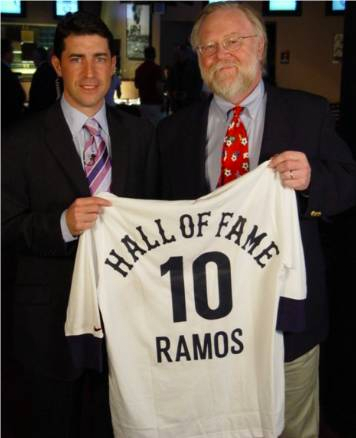
Jack Huckel, former director of the National Soccer Hall of Fame (NSHOF), reflects on the Society for American Soccer History (SASH). Huckel also founded JR Huckel & Associates, a consultation and management services firm for Hall of Fame elections. He served as president of the National Soccer Coaches Association of America and previously coached the men’s team at Skidmore College, Maine Maritime Academy, and George Mason University.
Describe the origins of SASH? What were some of its initial aims and goals?
The organizing moment was in conjunction with an Induction weekend in Oneonta. We thought to create a gathering place and vehicle for those interested in soccer history in the United States.
What was the state of US soccer history when SASH was founded?
I think Sam Foulds was American Soccer History – they were some others, but the field was of individuals. SASH was an effort to bring people with a common interest together.
Tell us about Sam Foulds and some of the other “founding fathers” of the Society.
Sam had spent ages collecting and disseminating the history of soccer, primarily in the U.S., but also some of its precursor information that set the game up.
How/when did you become involved in SASH? What was your role in the organization?
I had an interest in the 1950 team’s exploits and had done interviews with three of the players and had an article printed from those interviews. Through my association with the National Soccer Hall of Fame, I was invited to join others in discussions about founding a soccer history organization. I was tasked with developing a draft of constitution and by-laws for the organization. I did so basing it on SABR’s (Society for American Baseball Research) document.
Describe SASH’s connections with the National Soccer Hall of Fame (NSHOF).
Al Colone, Hall of Fame Executive Director, was an active participant in the organizing of SASH, so the connection with the Hall of Fame was important and meant to be mutually supportive.
What are some of the challenges SASH has faced as an organization?
Some of the same challenges the Hall of Fame faced – low visibility and general interest, particularly from popular media.
What are some of SASH’s accomplishments and contributions?
The regular meetings at the NSCAA Convention have kept SASH breathing and created opportunities for researchers to discuss their respective projects. The early newsletter was a good connecting vehicle. We helped organized a panel discussion at the Hall of Fame as well as at the Convention.
Tell us about the society’s journal/newsletter.
This was Roger Allaway’s project – it gave us an opportunity to stay connected and enthused about the work of our historian colleagues.
How did the closing of the NSHOF affect the Society?
It caused a dip in enthusiasm, I think, and dropped an important focal point of the work of historians. Also, the closing of the archive to active research has a negative impact.
How has the growth of soccer in the US since the Society’s founding affected interest in US soccer history?
I think interest has picked up with attendance at the NSCAA Convention meetings as evidence. Over the last few years more people have showed up and more publications have been noted.
What kind of progress has been made in the field of US soccer history since the founding of SASH?
The progress has been increased interest in historical events. I think the visible growth of the game, particularly on popular media, has significantly increased general interest, which has also increased questions about what went before.
What do you believe should be the aims/focus of the Society as it moves forward?
Facilitating, empowering, and promoting responsible research and its dissemination through all appropriate vehicles, from panel presentations at events to printed material of various forms.
The NSHOF is now in storage in North Carolina and, unfortunately, visitors can no longer visit the hall and its museum. What are some of your favorite artifacts from the collection?
- 1950 World Cup ball and jersey
- Al Harker 1934 jersey and boots
- 1991 Mary Harvey GK gloves
- Women’s World Cup trophies
Do any memorable stories/vignettes come to mind from your long association with SASH?
Just the fun and fond memories of talking to each other about our interest in soccer history. It brought me in touch with some players from the 1950 team – Walt Bahr, Harry Keough, Frank Borghi, John Souza,Gino Pariani, and, neatly, some years later, England goalkeeper Bert Williams!
